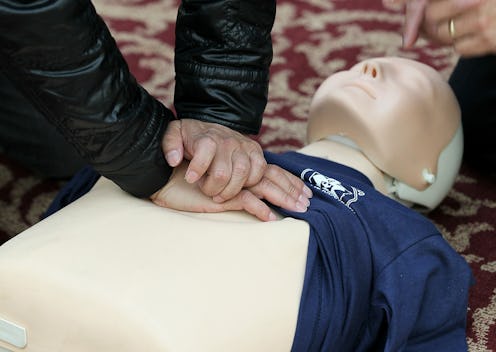Life
The Reason Why Women Are Less Likely To Get CPR Than Men Will Make You Want To Scream

If you go into cardiac arrest, receiving CPR can double or triple your chances of survival. The skill is so important that 35 states now require high school students to be CPR certified to graduate. Having someone deliver chest compressions while you wait for medical help could determine whether or not you live, but a new study finds that women are less likely to get CPR in public, and the reason why is beyond infuriating.
The researchers looked at nearly 20,000 cardiac cases in the U.S. and Canada. They found that 45 percent of men received CPR from bystanders, while only 39 percent of women could say the same. Lead author Audrey Blewer, the assistant director for Educational Programs at the Center for Resuscitation Science at the University of Pennsylvania, told the Associated Press people may be afraid they're hurting women — but they also may be afraid to touch their boobs.
"It can be kind of daunting thinking about pushing hard and fast on the center of a woman's chest," she said in the interview. Researchers also told the AP that people trained in CPR could be nervous about moving a woman's shirt or touching her chest, but they say that that's not at all necessary when doing CPR properly. "You put your hands on the sternum, which is the middle of the chest. In theory, you're touching in between the breasts," one of the study's authors, Dr. Benjamin Abella, told the AP.
Proper CPR technique shouldn't require a rescuer to touch a woman's breasts, but let's say it did require boob touching. If someone isn't breathing, shouldn't we be willing to help them at any cost? Ideally, the answer would be yes, but the reality is more complicated. When we've sexualized breasts to the point that public breastfeeding is looked down upon, it's not particularly surprising that bystanders are less likely to help women.
Additionally, when a cardiac emergency happens at home, men and women receive CPR at roughly the same rate. The gender discrepancy only applies to public scenarios where a person experiencing a medical emergency has to rely on the willingness of strangers to step in. Researchers say the study's results show the importance of educating the public about CPR.
"The key take away from these data is that we need to find better and more effective ways to educate the general public on the importance of providing bystander CPR, and the importance of being comfortable delivering it regardless of the factors like the gender, age, or even the weight of the person in need," said Abella in a press release. "This study and other investigations from our team are only just beginning to peel back the layers on CPR rates and training disparities, cardiac arrest survival, and the public's understanding of the importance of rapid intervention during a cardiac emergency."
Outside of a medical context, it makes sense to keep your hands to yourself, but nonsexual touch for the sake of saving a life is something else entirely. If my heart stopped beating, the last thing I'd worry about after the fact is whether someone had to put a hand near my boobs to save my life, and the thought that men are more likely to receive life-saving treatment because they don't have breasts is pretty depressing. Sexualizing a person's body in a non-sexual situation isn't just problematic because it perpetuates stereotypes: It's actually, literally, dangerous. Women are inadvertently being punished for something we have no control over, and it's a reminder we need to push back against over-sexualization whenever we see it. The potential consequences if we don't are terrifying.